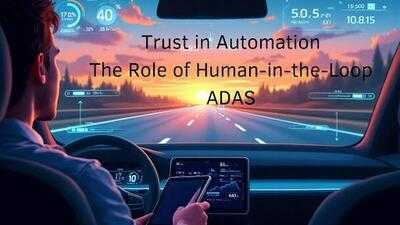
In this digital era, the rapid advancement of autonomous vehicle technology is revolutionizing transportation. However, building driver confidence in automation remains a crucial hurdle. Vraj Mukeshbhai Patel explores this issue in his research on advanced driver assistance systems (ADAS), highlighting how shared control between humans and AI fosters trust and safety in autonomous vehicles.
Bridging the Trust Gap in Automation
Despite the growing prevalence of ADAS, widespread trust in fully autonomous driving is still lacking. Many drivers remain skeptical about relinquishing full control to machines. Studies have shown that while younger drivers are more open to automation, older demographics exhibit hesitancy due to safety concerns and a lack of familiarity with AI-driven systems. This generational divide underscores the necessity of an approach that blends human oversight with machine intelligence. The HITL framework presents a balanced solution by integrating human judgment into AI-driven decision-making, creating a cooperative driving experience that reassures users while maintaining system efficiency.
The Evolution of Shared Control Systems
ADAS has evolved from essential cruise control to sophisticated semi-autonomous systems capable of real-time decision-making. The latest innovations incorporate multi-modal sensor fusion, combining data from LiDAR, radar, and cameras to enhance situational awareness. By adapting control authority dynamically, these systems ensure that human drivers remain actively engaged, allowing for intervention when necessary while minimizing unnecessary overrides. This evolving model of shared control establishes a structured approach to transitioning toward full automation, ensuring that drivers do not feel entirely disconnected from the driving experience.
Enhancing Safety Through Adaptive Learning
Machine learning continuously improves autonomous driving by analyzing driver behavior, predicting intentions, and adjusting automation levels. This adaptive learning enhances system responsiveness and builds trust in its reliability. Research shows that vehicles using adaptive control experience fewer overrides and greater prediction accuracy, increasing road safety. In high-risk scenarios like heavy traffic or adverse weather, AI-driven decision-making ensures optimal outcomes while keeping human oversight central.
Teleoperation and Remote Assistance: A Safety Net for Automation
When autonomous systems face uncertainties, remote human intervention provides critical support. Teleoperation allows trained operators to take control in complex conditions. VR-enhanced systems improve situational awareness, reducing response times and enabling smooth transitions between automation and manual control, particularly in unpredictable environments like construction zones or emergencies.
Human-Centric Design for Improved User Experience
Trust in automation relies on intuitive human-machine interfaces (HMI). Clear visual, auditory, and haptic feedback informs drivers of system status and road conditions. Well-designed HMIs boost feature use and security, while adaptive interfaces personalize alerts, enhancing engagement and preventing alarm fatigue in shared control.
Regulatory and Industry Implications
As autonomous technology evolves, regulations must ensure safety and reliability. Adopting standardized guidelines for shared control, data privacy, and real-time decision-making are crucial. Transparent, ethical AI development builds public trust, while clear liability rules define responsibility between human drivers and automated systems, enabling seamless ADAS integration.
Future Outlook: The Path to Full Automation
HITL ADAS builds trust in autonomy, paving the way for full automation. Progress requires planning, oversight, and AI refinement. Combining AI, real-time feedback, and human intuition enhances safety and efficiency, balancing automation with user-centric design and ethical AI practices.
In conclusion, Vraj Mukeshbhai Patel emphasizes that the success of autonomous driving technologies hinges on trust. By incorporating human oversight through HITL ADAS, the industry addresses key safety and psychological barriers. As advancements in AI, teleoperation, and adaptive learning continue to shape the future of mobility, a well-balanced approach between automation and human intervention will ensure a safer and more reliable transportation landscape. The fusion of intelligent automation with human guidance will lead to the next era of intelligent transportation, ensuring that trust remains at the heart of progress.